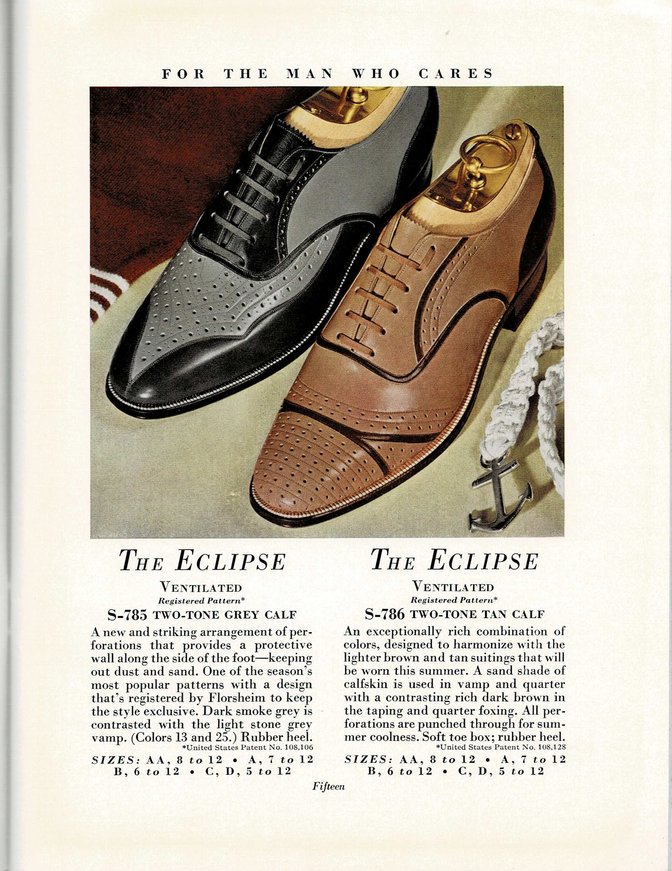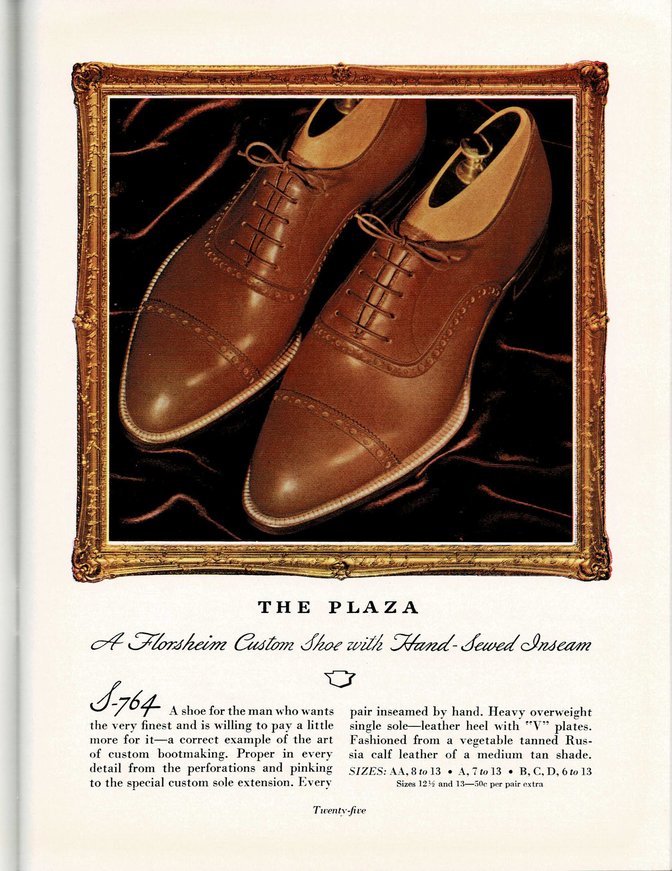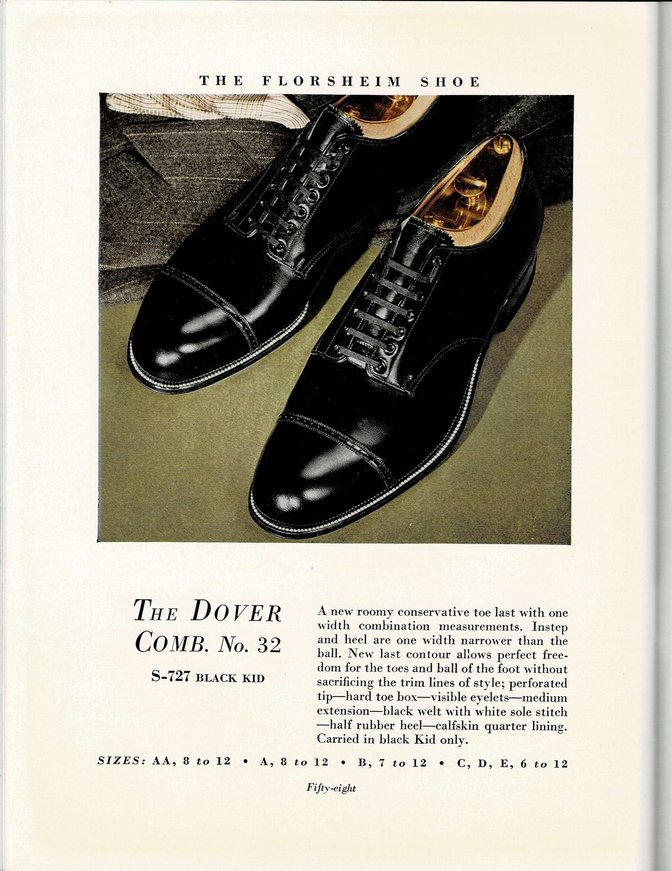The world is in turmoil so it’s obviously time to publish another catalog from my vintage shoe catalog collection. The lockdown can stop LeBron but it can’t stop vcleat.com.
This catalog takes us back to the spring of 1938 when Chicago based Florsheim Shoes was designing and manufacturing some of the best shoes in the world. The catalog was targeted to shoe retailers, not the general public. Unfortunately, it didn’t include a price list.
The shoes are amazing. Page after page. The Plaza and Savoy pairs must have been completely handmade. There are a variety of Rambler make ups. The French toe Rambler was a popular model that was made until 1979. Page 9 amuses me when it states that saddle shoes are “an old favorite that’s staging such a style comeback”.
People’s feet were smaller back in 1938. The largest size for many models was a 12 D. A few pairs could be purchased in size 13 or 14 for an extra $0.50.
What else was happening in 1938? One notable event was that the Captain dumped the Baroness, married a failed nun and hightailed it out of Salzburg to avoid time in the Kriegsmarine.
The catalog slogan is “For the man who cares”. I care. I do care to go back to the office. To wear grown up clothes daily. To shake hands. To have an in-person meeting. And if you are the elderly woman who yelled at me for passing within her six feet, again I am sorry. I do care.
Enjoy. Leave a comment if you care.
















































































David, thank you. This is so fascinating! It’s shocking how many similar styles there are with only nuanced differences. I sold shoes while I was in college both buyers and shoe reps constantly bitched about sales cannibalization. Presumably price point was a differentiator on all the black cap toes, but still’ to me, it shows Florsheim was more concerned with having the right shoe for each customer and feeling them coming back over time rather than quarterly turnover.
Thank you again, it’s truly fascinating!
Impressive! nuanced is a perfect term to use. Had to be made to order. Works of art!
Thanks. You are welcome.
No bluchers/derbies those days, interesting.
Whoops, there are some, sorry. Lost in the sea of oxfords.
Yes, almost all bals. There are a few bluchers on pages 46 and 71.
I find it interesting to see the many shoes with an orthopedic design for specific foot problems. Alden was very much the same and specialized in orthopedic shoes for many years. Great catalog contribution.
Thanks. I thought the same thing.
Great posting. Thank you. I often see references to the fact that our feet were smaller in the 30/40/50’s and wonder if the sizing scale was different back then or if there were just fewer people with large size feet. I. E. Would an 8.5 in today’s size be the same back then or would it be equivalent to a larger size, like a 9/9.5 in that period?
I read a few years ago that the average US size is at least one full size larger now. Our feet are also wider. There are not many E or EEE pairs in the catalog.
A number of factors make this difficult to ascertain. One thing I rarely hear mentioned is the role of vainety sizing. I’m not sure anyone ever actual had an AA width foot. However, when I sold shoes, old timers would come in asking for them for their 8D foot. Years ago, when people were more concerned with asthetics, a long narrow foot was percieved to be more attractive. So, the fellow with the 8D realized the width was similar to an 8.5C, a 9B, a 9.5A, and a 10AA. one guy told be they would pack the front of the shoe with newspapers to prevent them from distorting with wear. I heard the same story from numerous dapper gentleman in their 70s and 80s, so their must be at least truth to it. The size proportions width wise do work this way too.
Since stores still use the Brannock device, vanity sizing probably hasn’t come to shoes. I was surprised recently measuring my waist for a custom belt. It measures 37″ but I usually wear a 32.
I wondered similarly about vintage shoe sizing for many years. But was only able to answer that question in recent times when I snagged a few pre 1910’s shoes to compare. Both pairs were size 11 Narrows and to my surprise fit my modern foot perfectly. It’s no secret that finding really old men’s shoes in large sizes is not easy. Whatever system that was started way back when has apparently not changed in all these years.
Were white shoes really that popular back then?
These were the shoes for the spring and summer. Men dressed more formally back then so they might be more for vacations and weekends than the office.
How do you suppose those creased vamps broke in and stood up over time?
David,
This is incredible. Thank you for sharing. About what year did Florsheim start making a Longwing? Was surprised not to see any here.
Jim
The heavy gunboat long wing style became popular in the 1950s. All the manufacturers were making them by the late 1950s.
Great post as usual. What exactly do you think “hand-sewed inseam” refers to? Also, there are numerous shoes listed as being made in Russia calf, which I recall also seeing recently in another manufacturer’s vintage listing (forget who, maybe Alden) – any idea what Russia calf is/was? Stunning shoes all of these.
Thank you.
I am assuming “hand-sewed inseam” means that they sewed the welt directly into the insole rather than using a Goodyear welt process. They must have been special shoes. It would have been interesting to see the price on them.
My guess is that the Russian calf was probably made in the USA and not in Russia. It might have been a calfskin copy of the tanning recipe used in Russian reindeer leather. Which was a very special leather but the tannery and details were lost in the Russian Revolution.
My gosh! This is an amazing post.
Thank you!
Hello,David!
I am great fun of your H.P. in Tokyo and interested in Florsheim shoes’s s history. My name is Shin.
Please introduce me this catalog in my blog for japanese vintage shoes’s mania.
And I have 1928and1930 catalog. Please look my blog below.
http://shinnosukejedi.blog.fc2.com/blog-entry-139.html
http://shinnosukejedi.blog.fc2.com/blog-entry-206.html
I have a idea of florsheim shoes history’s current.
Ⅰ. sensitive smart shoes like handmade shoes preWWⅡ
Ⅱ.strong and hard shoes like The Miritary series in WWⅡ
Ⅲ.stylish and hard shoes like The Viking series post WWⅡ
Ⅳ.masculine and hard shoes like The Kenmoore series after 1950’s.
I thnk that The Miritary’s style in WWⅡ(like service shoes) have a great influence on florsheim’s shoemaking history.
I am so glad , if you give me your opinion.
I appreciate your great performance in this situation.
And sent you a big hug from far east country. Thanks!
Thank you so much for posting links to the 1928 and 1930 catalogs. You have some great shoes on your blog. It’s a shame that most of the pairs have been lost to history.
I am so glad to see my blog.
Bellow link is my tresure ! Bye.
http://shinnosukejedi.blog.fc2.com/blog-entry-166.html
“And if you are the elderly woman who yelled at me for passing within her six feet,…”
Tell her that SHE needs to get out of YOUR six foot zone.
BTW, thanks for the post and catalog.
Thanks for sharing this wonderful catalog.
So elegant and intriguing, looking at the current Florsheim, sigh.
Wonderful as always. Absolute works of art.
I’ll take one of each, please. Amazing. thanks for sharing
Hi
I’m a shoe fanatic with a special taste for vintage and US made shoes.
I just discovered your blog and I’m thrilled !
Thanks so much for producing all this content.
Long reading nights awaiting me…
Eric from Paris
I enjoyed this thanks!
Coming from England I was surprised to see “The Stroller” veldtschoen derby. I never realised any US makers did this English style of shoe.
The Stroller was the only shoe in the catalog with a 360 degree welt.
What an amazing array of two-tones, spectators, and white shoes.
Enjoyable viewing. Thanks for providing it. This website is a great resource, and enjoyable entertainment.
My Grandfather born is 1897 south side of then Irish Italian Chicago and would have bought and worn many of these cataloged shoes as a longtime salesman for US Steel. Great to see.
David, I have the price list sheet for your catalog. Would you like me to send you an image of it?
All the best,
Marc Chevalier
Wow. Yes. Send it to david at vcleat.com
Rereading this catalog makes me think: beautiful, elegant shoes, without a doubt, but in 1938 the country is still trying to drag its way out of the Great Depression. I can’t imagine any of these fancy shoes sold very much.
Florsheim were one of the largest shoe companies in the US (possibly the world) for many years including 1938. The Chicago factory had 2500+ employees, 9000+ retailers and output would have been in the millions of pairs during this time. Florsheim were slightly more than average in price and maybe a little bit of a stretch for the average man hence the ‘Goddamn Florsheim shoe’ line in Chinatown (still a good shoe in 1974 too).
Plenty of white bucs, a staple of the Ivy style. Do you suppose the two-tone spectator evolved from spats (spatterdashes, or spatter guards)?
I hadn’t thought of that but you may be right.
I just found a pair of the Comb. boots in brown at a thrift store. They are in immaculate condition and I’m shocked to see them in a catalog this old. I’d be surprised if these were worn more than once or twice. The leather is still soft and supple and the inside of the boot shows no wear. I’m wondering if anyone knows if these shoes were made other years as well. The inside of the boot says Ped-Flex Process. Thanks for your help.
You can send me a few photos. My email is on the contact page.